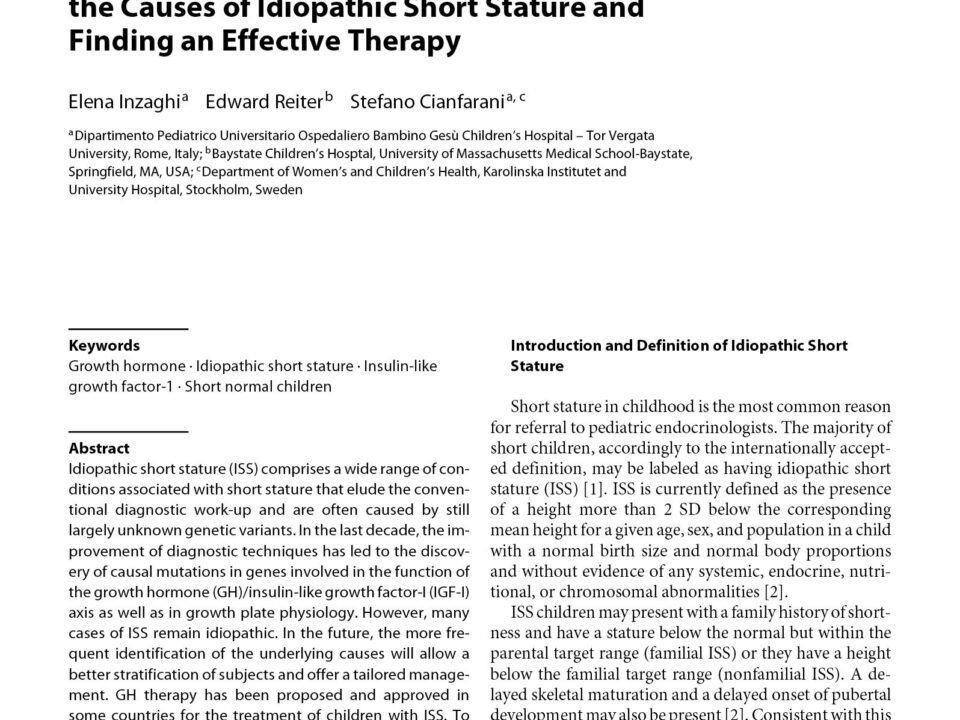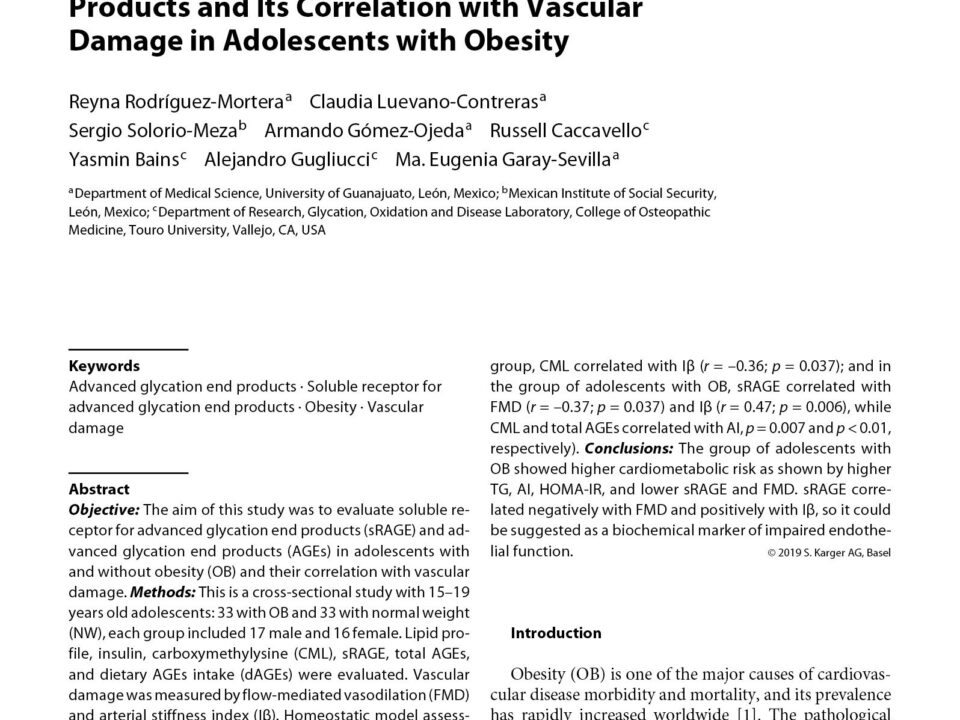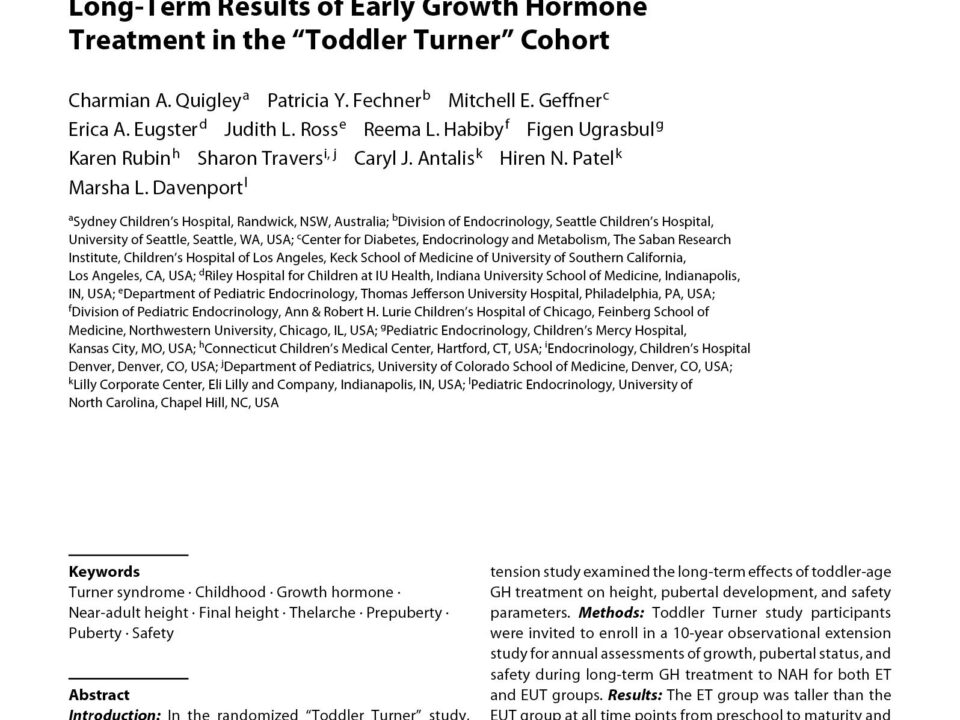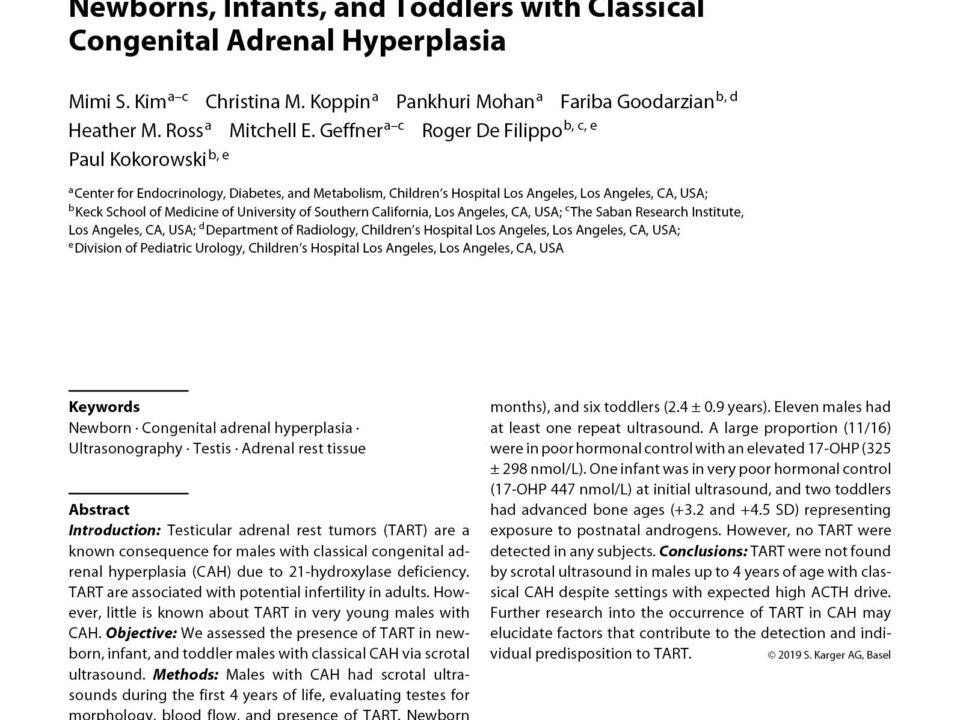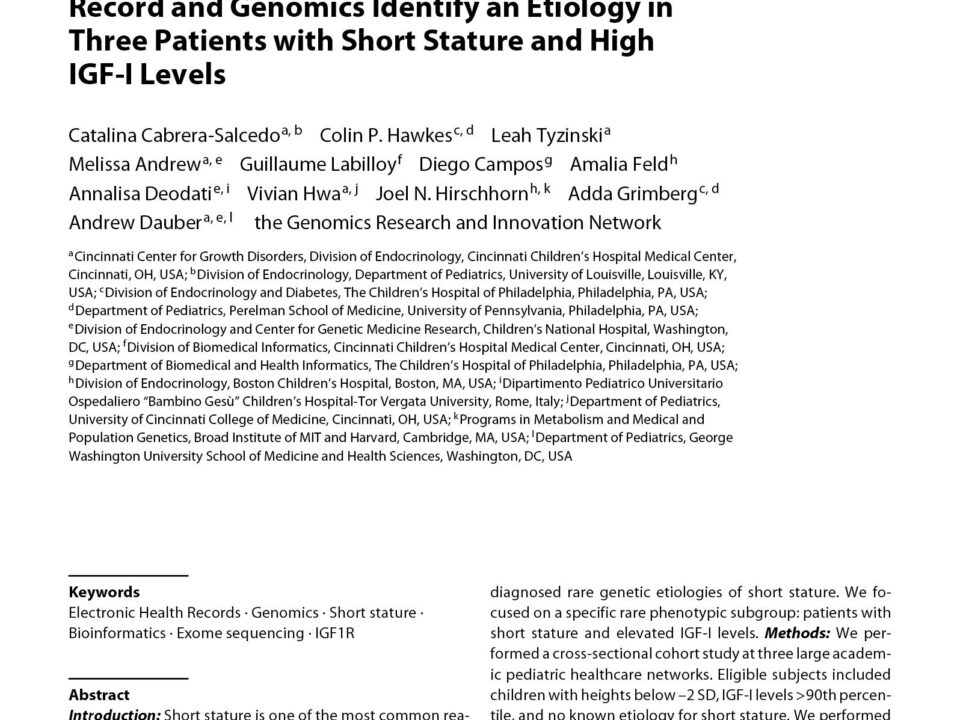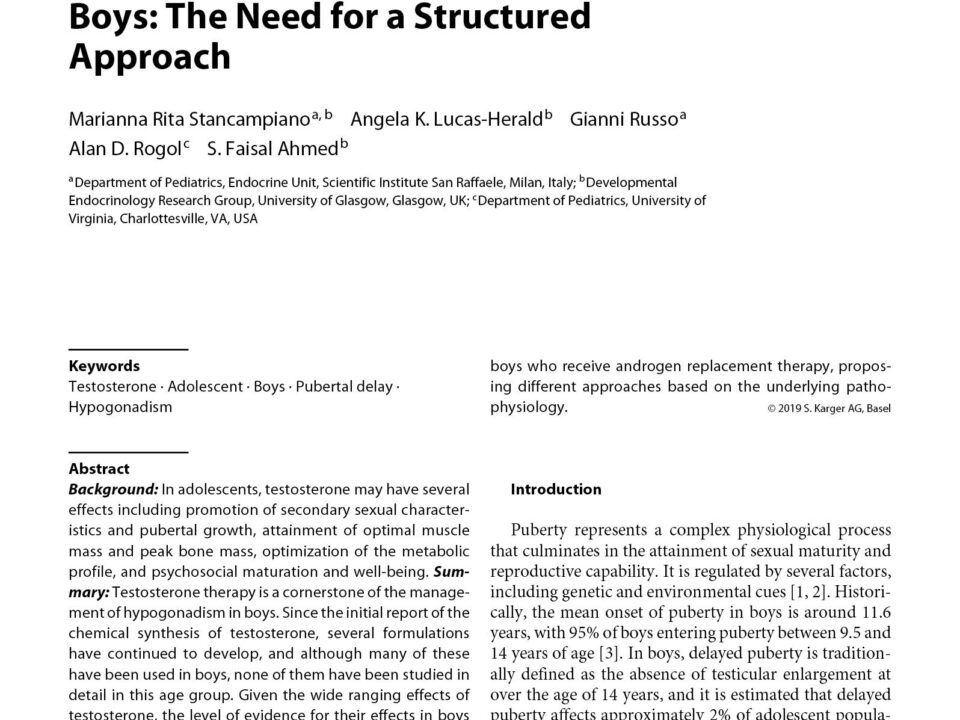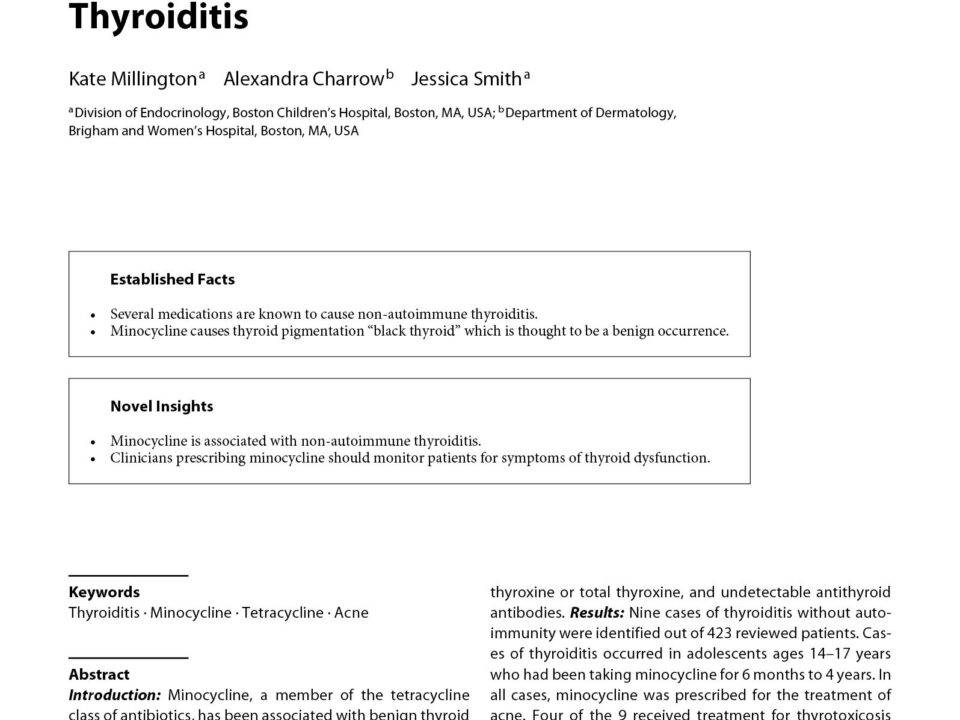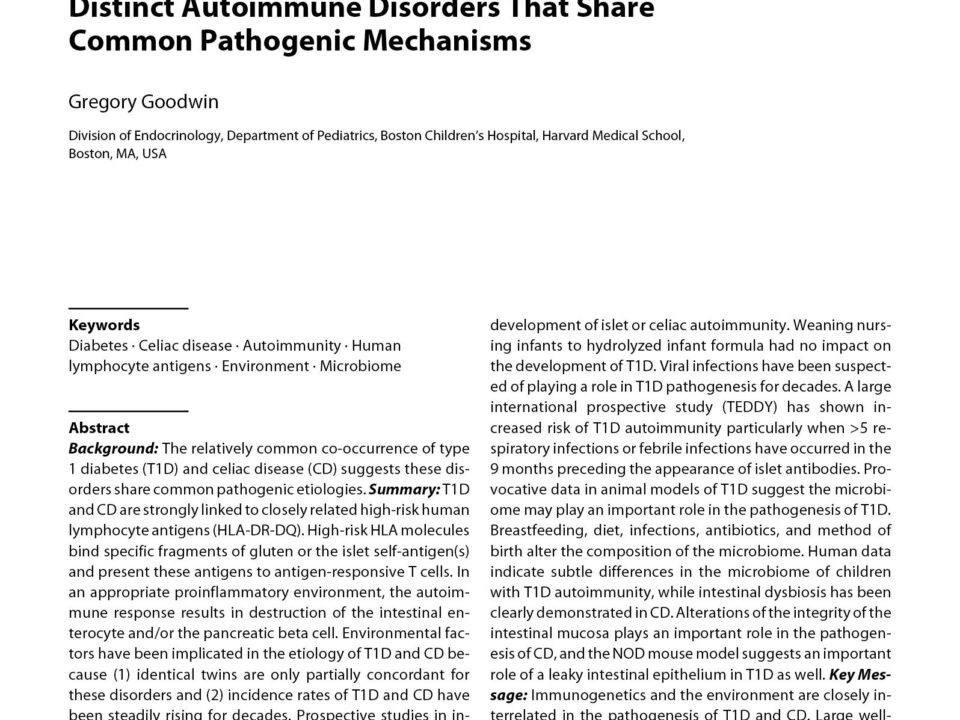December 13, 2022
Idiopathic short stature (ISS) comprises a wide range of conditions associated with short stature that elude the conventional diagnostic work-up and are often caused by still largely unknown genetic variants. In the last decade, the improvement of diagnostic techniques has led to the discovery of causal mutations in genes involved in the function of the growth hormone (GH)/insulin-like growth factor-I (IGF-I) axis as well as in growth plate physiology. However, many cases of ISS remain idiopathic. In the future, the more frequent identification of the underlying causes will allow a better stratification of subjects and offer a tailored management. GH therapy has been proposed and approved in some countries for the treatment of children with ISS. To improve the efficacy of GH therapy, trials with GH combined with GnRH agonists, aromatase inhibitors, and even IGF-I have been conducted. This review aims to revise the current definition of ISS and discuss the management of children with ISS on the basis of the most recent evidence.
December 13, 2022
Objective: The aim of this study was to evaluate soluble receptor for advanced glycation end products (sRAGE) and advanced glycation end products (AGEs) in adolescents with and without obesity (OB) and their correlation with vascular damage. Methods: This is a cross-sectional study with 15–19 years old adolescents: 33 with OB and 33 with normal weight (NW), each group included 17 male and 16 female. Lipid profile, insulin, carboxymethylysine (CML), sRAGE, total AGEs, and dietary AGEs intake (dAGEs) were evaluated. Vascular damage was measured by flow-mediated vasodilation (FMD) and arterial stiffness index (Iβ). Homeostatic model assessment-insulin (HOMA-IR) and atherogenic index (AI) were calculated. Results: The group with OB had higher triglycerides (TG; p < 0.0001), AI (p < 0.001), HOMA-IR (p < 0.0001), dAGEs intake (p < 0.0001), lower CML (p = 0.05), total AGEs (p < 0.01), sRAGE (p < 0.001), and FMD (p < 0.002). In the total group, sRAGE correlated with AI (r = –0.26 p = 0.037); in the NW group, CML correlated with Iβ (r = –0.36; p = 0.037); and in the group of adolescents with OB, sRAGE correlated with FMD (r = –0.37; p = 0.037) and Iβ (r = 0.47; p = 0.006), while CML and total AGEs correlated with AI, p = 0.007 and p < 0.01, respectively). Conclusions: The group of adolescents with OB showed higher cardiometabolic risk as shown by higher TG, AI, HOMA-IR, and lower sRAGE and FMD. sRAGE correlated negatively with FMD and positively with Iβ, so it could be suggested as a biochemical marker of impaired endothelial function.
December 13, 2022
Background/Aims: Thyroid hormones (TSH) play a key role in the working of the cardiovascular system, with direct effects on cardiac function, vascular system, and atherosclerotic factors. Epicardial adipose tissue, the visceral fat of the heart, has emerged as a new cardiometabolic risk marker because of its close anatomical proximity to the myocardium and coronary artery. This study aimed to evaluate epicardial fat thickness (EFT) in children with subclinical hypothyroidism (SH) and its relation to early atherosclerotic changes. Methods: The study included 32 children with SH due to autoimmune thyroiditis and 32 healthy children matched for age and gender as control group. Patients and controls underwent anthropometric evaluation and measurement of fasting lipids, glucose, insulin, homeostasis model assessment for insulin resistance and high-sensitivity C-reactive protein (hs-CRP). TSH, free thyroxine (FT4 and FT3) and antithyroid autoantibodies (antithyroid peroxidase and thyroglobulin antibodies) were also measured. Conventional echocardiography was used to assess EFT. Noninvasive ultrasound was used to measure carotid intima-media thickness and brachial artery flow-mediated dilation (FMD) responses. Results: Compared to controls, patients had higher atherogenic index (AI) and hs-CRP (p = 0.001 for each). Conventional echocardiography revealed that patients with SH had higher EFT (p = 01) and significantly lower FMD response compared with the control (p = 0.001). In multivariate analysis, EFT values were significantly correlated with TSH (OR 1.2; 95% CI 1.04–1.34; p = 0.01), hs-CRP (OR 1.1; 95% CI 1.09–1.14; p = 0.001, AI (OR 1.6; 95% CI 1.17–2.03; p = 0.001), and FMD response (OR 2.4; 95% CI 1.14–2.53; p = 0.01). Conclusions: Our study demonstrated that EFT is higher in children with SH compared with controls and associated with FMD responses. Measurement of EFT by echocardiography in children with SH may help to identify those at high risk of developing subclinical atherosclerosis.
December 13, 2022
Background: Girls with Turner syndrome (TS) have a high incidence of primary ovarian insufficiency. Recent data show rates of spontaneous thelarche (ST) of 38% and spontaneous menarche (SM) of 15–16%, with higher rates in those with mosaicism. Summary: We systematically reviewed the literature for evidence regarding rates of ST and SM in TS and evaluated rates based on the type of chromosomal mosaicism. We searched MEDLINE via PubMed, Embase, and the Cochrane Database of Controlled Trials. Reference lists were screened. Studies reporting outcomes of ST and SM in girls with TS, diagnosed by genetic analysis, were included. Data was collected regarding study design, cohort type, cohort age, the number of participants with ST and SM, the individual age at diagnosis of ST and SM, the mean age of patients with ST and SM, sample size, the number of participants with secondary amenorrhea, and karyotype. Key Messages: In total 2,699 patients were assessed for ST and 2,890 for SM from 43 articles. Overall the rates of ST were 32% (95% CI 26.4–38.9) and SM 20.8% (95% CI 19.3–22.4). Girls with X monosomy had the lowest rates of ST (i.e., 13%; 95% CI 8.7–19.7) and SM (i.e., 9.1%; 95% CI 7.3–11.3). Girls with 45,X/47,XXX had the highest rates of ST (i.e., 88.1%; 95% CI 62–97.1) and SM (i.e., 66.2%; 95% CI 49.3–79.6). Conclusions: Rates of ST and SM differ by karyotype in TS. When counseling patients, the karyotype should strongly influence discussions regarding pubertal development and the future reproductive potential.
December 13, 2022
Introduction: Testicular adrenal rest tumors (TART) are a known consequence for males with classical congenital adrenal hyperplasia (CAH) due to 21-hydroxylase deficiency. TART are associated with potential infertility in adults. However, little is known about TART in very young males with CAH. Objective: We assessed the presence of TART in newborn, infant, and toddler males with classical CAH via scrotal ultrasound. Methods: Males with CAH had scrotal ultrasounds during the first 4 years of life, evaluating testes for morphology, blood flow, and presence of TART. Newborn screen 17-hydroxyprogesterone (17-OHP) and serum 17-OHP at the time of ultrasound were recorded. Bone ages were considered very advanced if ≥2 SD above chronological age. Results: Thirty-one ultrasounds in 16 males were performed. An initial ultrasound was obtained in four newborns at diagnosis (6.8 ± 2.1 days), six infants (2.2 ± 0.9 months), and six toddlers (2.4 ± 0.9 years). Eleven males had at least one repeat ultrasound. A large proportion (11/16) were in poor hormonal control with an elevated 17-OHP (325 ± 298 nmol/L). One infant was in very poor hormonal control (17-OHP 447 nmol/L) at initial ultrasound, and two toddlers had advanced bone ages (+3.2 and +4.5 SD) representing exposure to postnatal androgens. However, no TART were detected in any subjects. Conclusions: TART were not found by scrotal ultrasound in males up to 4 years of age with classical CAH despite settings with expected high ACTH drive. Further research into the occurrence of TART in CAH may elucidate factors that contribute to the detection and individual predisposition to TART.
December 13, 2022
Introduction: Short stature is one of the most common reasons for referral to a pediatric endocrinologist and can result from many etiologies. However, many patients with short stature do not receive a definitive diagnosis. Objective: To ascertain whether integrating targeted bioinformatics searches of electronic health records (EHRs) combined with genomic studies could identify patients with previously undiagnosed rare genetic etiologies of short stature. We focused on a specific rare phenotypic subgroup: patients with short stature and elevated IGF-I levels. Methods: We performed a cross-sectional cohort study at three large academic pediatric healthcare networks. Eligible subjects included children with heights below –2 SD, IGF-I levels >90th percentile, and no known etiology for short stature. We performed a search of the EHRs to identify eligible patients. Patients were then recruited for phenotyping followed by exome sequencing and in vitro assays of IGF1R function. Results: A total of 234 patients were identified by the bioinformatics algorithm with 39 deemed eligible after manual review (17%). Of those, 9 were successfully recruited. A genetic etiology was identified in 3 of the 9 patients including 2 novel variants in IGF1R and a de novo variant in CHD2. In vitro studies supported the pathogenicity of the IGF1R variants. Conclusions: This study provides proof of principle that patients with rare phenotypic subgroups can be identified based on discrete data elements in the EHRs. Although limitations exist to fully automating this approach, these searches may help find patients with previously unidentified rare genetic disorders.
December 13, 2022
Background: In adolescents, testosterone may have several effects including promotion of secondary sexual characteristics and pubertal growth, attainment of optimal muscle mass and peak bone mass, optimization of the metabolic profile, and psychosocial maturation and well-being. Summary: Testosterone therapy is a cornerstone of the management of hypogonadism in boys. Since the initial report of the chemical synthesis of testosterone, several formulations have continued to develop, and although many of these have been used in boys, none of them have been studied in detail in this age group. Given the wide ranging effects of testosterone, the level of evidence for their effects in boys and the heterogeneity of conditions that lead to early-onset hypogonadism, a standardized protocol for monitoring testosterone replacement in this age group is needed. Key Messages: In this review, we focus on the perceived benefits of androgen replacement in boys affected by pubertal delay and highlight the need to improve the health monitoring of boys who receive androgen replacement therapy, proposing different approaches based on the underlying pathophysiology.
December 13, 2022
Introduction: Minocycline, a member of the tetracycline class of antibiotics, has been associated with benign thyroid pigmentation but reports of thyroid dysfunction are sparse. Methods: Cases were selected via an inquiry of the electronic medical records for patients with thyroid dysfunction and the use of a tetracycline antibiotic. Non-autoimmune thyroiditis was defined as abnormally low or suppressed thyroid-stimulating hormone (TSH, <0.3 µIU/mL), elevated free thyroxine or total thyroxine, and undetectable antithyroid antibodies. Results: Nine cases of thyroiditis without autoimmunity were identified out of 423 reviewed patients. Cases of thyroiditis occurred in adolescents ages 14–17 years who had been taking minocycline for 6 months to 4 years. In all cases, minocycline was prescribed for the treatment of acne. Four of the 9 received treatment for thyrotoxicosis with a β-blocker (in 3 cases) and/or antithyroid drug (in 2 cases). Thyroiditis was symptomatic in all but one individual who presented with painless goiter. All thyroiditis was transient and resolved after a median of 4.5 months (range 2–5 months). In one case, thyroiditis was followed by transient hypothyroidism. Discussion: Minocycline is known to cause thyroid abnormalities, although it has not been definitively linked to thyroid dysfunction. Here, we report 9 cases of non-autoimmune thyroiditis in adolescents receiving minocycline for acne. We recommend that minocycline exposure be considered in the differential diagnosis for thyroiditis and that patients receiving minocycline be counseled regarding the risk of thyroid dysfunction.
December 13, 2022
Background: The relatively common co-occurrence of type 1 diabetes (T1D) and celiac disease (CD) suggests these disorders share common pathogenic etiologies. Summary: T1D and CD are strongly linked to closely related high-risk human lymphocyte antigens (HLA-DR-DQ). High-risk HLA molecules bind specific fragments of gluten or the islet self-antigen(s) and present these antigens to antigen-responsive T cells. In an appropriate proinflammatory environment, the autoimmune response results in destruction of the intestinal enterocyte and/or the pancreatic beta cell. Environmental factors have been implicated in the etiology of T1D and CD because (1) identical twins are only partially concordant for these disorders and (2) incidence rates of T1D and CD have been steadily rising for decades. Prospective studies in infants genetically predisposed to T1D and CD showed that antibody positivity to both disorders begins in the first 1–3 years of life. Viral infections and early exposure to gluten or cow’s milk in the infant diet have been implicated in disease pathogenesis. However, delaying introduction of gluten in the infant diet until 12 months of age had no impact on the development of islet or celiac autoimmunity. Weaning nursing infants to hydrolyzed infant formula had no impact on the development of T1D. Viral infections have been suspected of playing a role in T1D pathogenesis for decades. A large international prospective study (TEDDY) has shown increased risk of T1D autoimmunity particularly when >5 respiratory infections or febrile infections have occurred in the 9 months preceding the appearance of islet antibodies. Provocative data in animal models of T1D suggest the microbiome may play an important role in the pathogenesis of T1D. Breastfeeding, diet, infections, antibiotics, and method of birth alter the composition of the microbiome. Human data indicate subtle differences in the microbiome of children with T1D autoimmunity, while intestinal dysbiosis has been clearly demonstrated in CD. Alterations of the integrity of the intestinal mucosa plays an important role in the pathogenesis of CD, and the NOD mouse model suggests an important role of a leaky intestinal epithelium in T1D as well. Key Message: Immunogenetics and the environment are closely interrelated in the pathogenesis of T1D and CD. Large well-designed prospective studies in at-risk populations informed by scientifically rigorous studies in animal models are likely to have the greatest impact on our understanding of the complex pathogenesis of these detrimental autoimmune disorders.
